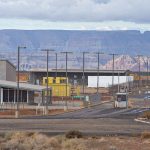
LOC begins long road in approval processes to expand judicial, public safety facilities plans
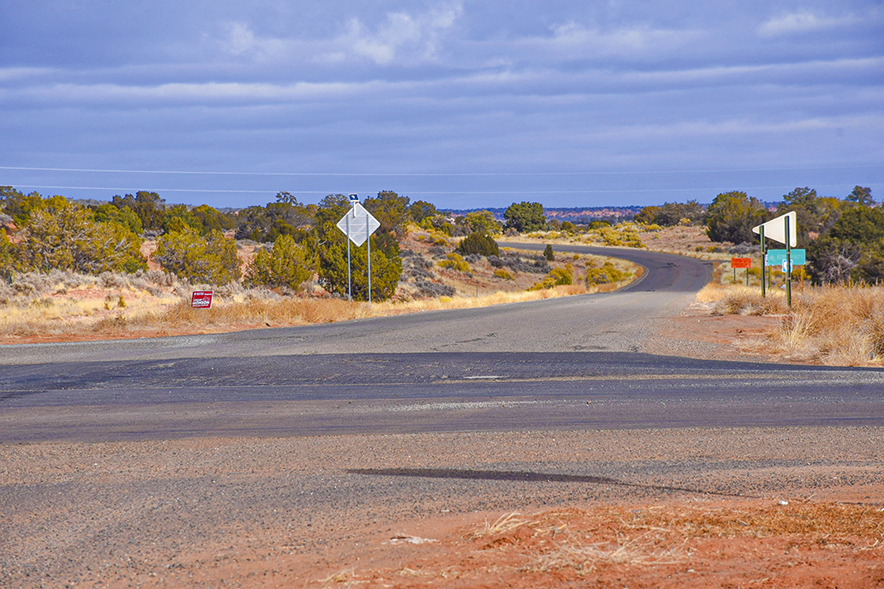
Navajo Times | Krista Allen
The Crossroads of State Route 98 and Navajo Route 16, near Ts’ahbiikin, is empty on Friday, Dec. 27.
WINDOW ROCK
The Navajo Nation has taken a step toward enhancing its judicial and public safety infrastructure with the enactment of Legislation 0229-24. Sponsored by Delegate Eugenia Charles-Newton, the Law and Order Committee chair, this bill establishes the Judicial/Public Safety Facilities Fund Priority List for fiscal 2023 and 2024.
This collaborative agreement between the Judicial Branch and the Division of Public Safety addresses long-standing gaps in critical infrastructure across the Nation. The legislation prioritizes five key projects for immediate funding and development.
These projects include a multi-functional complex in Shiprock which will integrate judicial, public safety, correctional, and medical examiner facilities. Fort Defiance will also receive an expanded facility for the Navajo Division of Public Safety, including headquarters and judicial district offices. In Chinle, Charles-Newton’s legislation would designate a training academy that would enhance police, investigations, and corrections capabilities. In Dilkon, the community is slated for the construction of facilities to support integrated law enforcement operations.
An amended provision in the legislation broadens the scope of consideration to include additional communities across the Navajo Nation, such as Ramah, Window Rock, Aneth, Alamo, Pueblo Pintado, Tóhajiileehé, Tohatchi, Leupp, Kaibeto, and Cameron.
These proposed expansions reflect the tribe’s commitment to addressing the long-standing needs of communities that have consistently lacked adequate access to public safety and judicial services. The inclusion of these communities stems from extensive discussions and input from local chapters, many of which highlighted the pressing urgency of their infrastructure requirements.
Shaping final legislation, NOST area challenges
Local advocacy played a role in shaping the final legislation. Communities like Ts’ahbiikin, Kaibeto, Piñon, and Aneth submitted formal resolutions and documentation in support of the initiative.
Ts’ahbiikin, strategically located along heavily trafficked routes and serving as a hub for residents and tourists, emphasized the severe consequences of delays in emergency response. They stressed an urgent need for a public safety substation to significantly reduce response times and save lives. Given that land has already been designated and utilities are in place, Ts’ahbiikin Chapter leaders expressed their readiness to commence construction immediately.
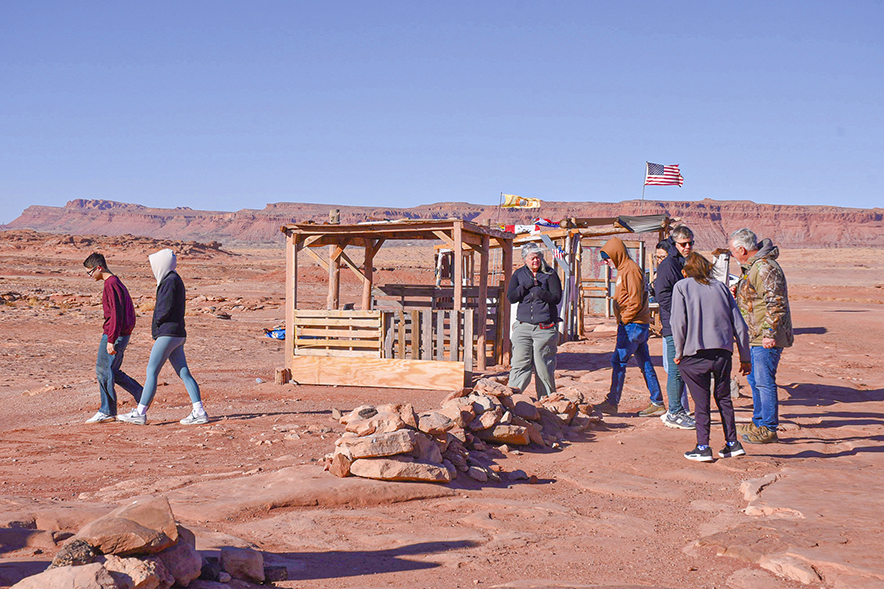
Navajo Times | Krista Allen
Tourist mingle as they visit at the Dinosaur Tracks along U.S. Route 160 near Tónaneesdizí on Friday, Dec. 27.
Ts’ahbiikin, Aneth, and Piñon have formally presented urgent appeals to the LOC to address critical gaps in judicial and public safety infrastructure. Each chapter highlighted unique challenges and proposed well-developed plans to meet their communities’ essential needs.
The Ts’ahbiikin Chapter has emphasized the urgent need to reinstate a Public Safety Substation on the Judicial/Public Safety Facilities Fund Priority List for fiscal 2023 and 2024. Located at the intersection of State Route 98 and Navajo Route 16, the chapter serves as a vital hub for Northern Arizona communities and a major corridor for over 300,000 tourists annually visiting Monument Valley and Antelope Canyon. With a new road connecting Navajo Mountain to Oljato on the horizon, traffic is projected to increase by 20 to 30 percent in the coming years.
Despite its strategic location, emergency response teams are over an hour away in either Kayenta or Tuba City, resulting in dangerous delays during critical situations. Dellard Curley, Ts’ahbiikin Chapter’s secretary-treasurer, underscored the devastating impact of these delays in a letter to the committee.
“This project is not merely about public safety,” Curley emphasized. “It addresses the glaring gaps in emergency response times that have put our residents and visitors at substantial risk.”
Curley highlighted a 2023 car accident on Navajo Route 16, where victims endured over an hour of waiting for assistance, worsening their injuries. He emphasized that response times in the area exceed 60 minutes, significantly surpassing the national rural average of 14 minutes.
The chapter has designated land in the Crossroads area for the proposed substation. Utilities such as water, electricity, and access roads are already in place, facilitating the construction of the substation without delay.
Beyond enhancing response times, the project would create economic opportunities for the community, including administrative and first-responder roles. Curley stated that the project is more than just a facility; it’s a commitment to the residents, visitors, and future of the community.
Utah Navajo, NPL projects
The Aneth Chapter in southeastern Utah has also advocated for substantial investments in public safety and judicial infrastructure. Since 2012, law enforcement and judicial services have operated out of temporary modular buildings, a temporary solution that fails to address the community’s long-term needs.
In February 2024, the chapter passed Resolution ACFEB-24-032, requesting an amendment to current legislation to prioritize the construction of a First Responder Facility project. The resolution allocates eight acres within a 24-acre land withdrawal for the development of a permanent court facility and police substation.
Vice President Elmerson Phillips outlined the chapter’s progress in a memorandum to the LOC. Recent activities include programming for the proposed buildings, site layout planning, access road construction, and a utility capacity study. These efforts have been supported by State of Utah appropriations and federal American Rescue Plan Act funds.
“The Aneth Chapter community and surrounding areas consistently express the urgent need for timely law enforcement services and other first responders,” Phillips wrote. He also highlighted the potential to attract additional support from the Utah delegation through congressional earmarks by advancing the project.
Phillips emphasized that selecting Aneth projects would address historic disparities in service delivery to the Utah portion of the Navajo Nation. He stated that this project represents a collaborative effort to ensure safety and justice for the Aneth community and surrounding areas.
In the Navajo Partitioned Lands, the Piñon Chapter has highlighted the critical need for a Public Safety and Justice Center. The chapter submitted Resolution PIN-24_84 to the Navajo Nation Council, underscoring the unique challenges faced by the chapter due to the legacy of federal policies that displaced Navajo families under Public Law 93-531. These policies disrupted the region’s social and economic foundation, leaving the community with inadequate infrastructure and insufficient support.
The proposed center is part of the Dził Yijiin Judicial and Public Safety Complex and is currently in the design and engineering phase. Detailed blueprints submitted with the resolution provide a comprehensive overview of the facility, which includes judicial courts, law enforcement offices, ambulance and fire engine bays, emergency medical services, and storage spaces.
Piñon Chapter’s response emphasized that the center would provide essential services and enhance safety for the entire community. The blueprint incorporates multiple functions to streamline operations and ensure accessibility for surrounding areas.
With an influx of Navajo families seeking refuge in the region, the strain on public services has intensified, making the completion of the center a top priority, stated the response from the Piñon Chapter.
Gaps in judicial, public safety services
The appeals from the Ts’ahbiikin, Aneth, and Piñon chapters reflect a broader effort across the Navajo Nation to address gaps in judicial and public safety services. Each chapter has presented comprehensive plans and demonstrated their readiness to commence their respective projects. These projects highlight the unique challenges they face while aligning with the Nation’s broader priorities.
Legislation 0229-24, if approved, establishes a framework for prioritizing and allocating resources based on readiness and community needs.
New Mexico Secretary on Indian Affairs Josett Monette visited several communities in Eastern Agency, including Shiprock, where she heard from Shiprock Chapter officials and law enforcement from the Shiprock Police District.
“This building was the old post office. I used to come here as a kid to check our mailbox. Now, it serves as our police department,” said Shiprock Chapter President Nevina D. Kinlahcheeny on Nov. 26. “We’re working with a portable jail, but it’s just a temporary fix. We really need a new police department.”
Monette asked detailed questions about the community’s needs, including daily police call volumes, collaborations with federal agencies, and long-term goals for public safety.
A central topic of discussion was the Shiprock First Incident Command Center, a proposed 25,500-square-foot facility to house police officers, EMTs, firefighters, and emergency management teams. Currently, Shiprock’s police officers work out of the old post office, EMTs operate from a conference room at Northern Medical Center, and firefighters are based in an aging fire station.
The SFICC project is estimated to cost $15.9 million. While New Mexico has committed $12.1 million and the Navajo Nation Division of Community Development has allocated $1 million in matching funds, a funding gap of $3.7 million remains. An additional $1 million is needed for furniture, fixtures, and equipment.
“We cannot continue operating effectively under these conditions,” Kinlahcheeny said.
Kinlahcheeny added the urgency of the need for additional funding to keep the projects going.
“I can spend $8.6 million but I can’t spend $200,000 because I need $900,000 to finish the project, but if I’m only getting $200,000 then I’m not able to do the project. So, yeah, I have one potato,” she said.

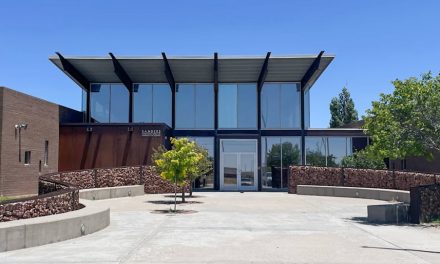
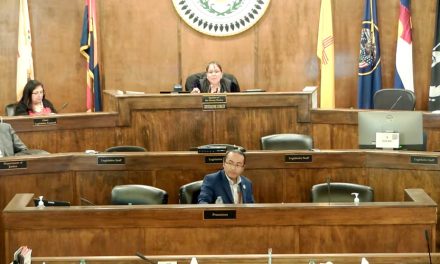





 Highway 264,
Highway 264, I-40, WB @ Winslow
I-40, WB @ Winslow